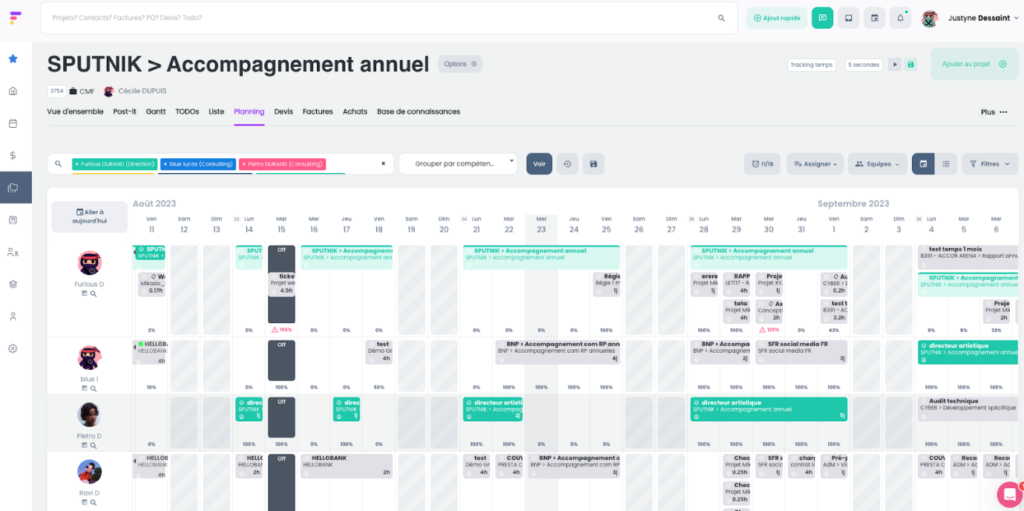In brief
- Dazzling growth: from 0 to over 50 employees in 4 years.
- Annual growth of 50%, with the recruitment of 22 people per year.
- Working with companies from 10 to 100 employees (90% of new customers are acquired by word-of-mouth).
- Furious has enabled us to manage rapid expansion efficiently, while maintaining quality service.
- Sustained development thanks to optimized management via Furious.
Initial challenges & objectives
Faced with rapid growth, from 0 to 55 employees in four years, SMASH Group felt the need to optimize its time management and centralize its tools to maintain the quality of service offered to its customers, while anticipating time overruns and therefore potential needs for additional staffing to be activated flexibly.
Their main objective
- Improve team visibility and time management to avoid overwork and optimize profitability.
Their secondary objectives
- Better planning
- Provide concrete metrics to clients regarding time spent on projects.
Who are they?
- Consulting firm, shared-time functions (HR, Legal, Financial)
- France – Paris / Marseille
- Founded in 2018
- 55 employees (+22 per year)
Results with Furious
— Clear visibility
Staffing, scheduling, time spent per customer in 2 clicks.
— 1 unique tool
To manage projects and employee availability (from 0 to 50 employees in 4 years) as well as sales/margin management
— A view of essential KPIs
Dynamic, with the ability to monitor and secure data
Before Furious
Before integrating Furious, SMASH worked mainly with Excel files to track working hours and manage administrative tasks. Although practical, this method was seriously lacking in dynamism and didn’t allow us to see the teams’ workloads in real time. The result was a general inefficiency in project management and a lack of flexibility that was sorely felt, especially in a context of strong growth. Jean-Baptiste, co-founder of SMASH, tells us:
We've gone from the medieval to the digital era. With the arrival of Furious, we've moved into a much more dynamic era, with monitoring and, of course, data security.
Jean-Baptiste Cousin
SMASH had clear objectives: to anticipate, plan and staff better, to reduce team stress due to work overload, and to ensure that every minute worked was correctly tracked and allocated to optimize profitability.
Management also wanted to ensure that the teams themselves could see and plan their future workloads (one of the keys to avoiding unpleasant surprises and delays).
After Furious
The integration of Furious has solved several problems at SMASH.
Real-time tracking
This functionality was crucial for SMASH, which wanted to ensure that its teams were not overwhelmed, to be able to anticipate potential recruitments even before new customers were signed, and to plan their tasks optimally. Jean-Baptiste states:

Jean-Baptiste Cousin, co-founder of SMASH
We use Furious to monitor time very precisely, firstly to make sure we're not overloading them and putting them in stressful situations.
Planning and task allocation
In addition to real-time tracking, detailed schedules by team and project have been set up. Thanks to these shared schedules and automatic reminders configured for certain actions (task reminders, invoicing, vacation periods, etc.), task distribution and anticipation of periods of heavy workload have been greatly improved.
There's nothing worse than not knowing how you're going to work, or what you'll be working on in the future. So it's also a planning issue.
Jean-Baptiste Cousin
2-click tracking and easy management control
SMASH Group’s management was facing a persistent problem of lack of visibility over what was really happening within the teams, especially with the team’s rapid growth. This problem was solved with the introduction of Furious.
With Furious, it’s now possible to track team performance and workloads in just a few clicks, enabling more precise and efficient management. Management can now see in real time how projects are progressing, which teams are overloaded and where adjustments are needed, facilitating rapid, informed decision-making.
Jean-Baptiste's 3 favorite killing features
Feature #1: Project progress
My first favorite feature is the little widget for moving the cursor, allowing you to declare your time in a fun way, with a macro view of all your projects.
Jean-Baptiste Cousin
This feature makes time tracking simple and engaging for teams, improving adoption and use of the tool, and in turn increasing visibility of profitability status by project. Here’s the proof:

This widget allows users to quickly and easily report time spent on projects. – more precisely, the status of each project, providing a clear and intuitive overview: are you behind schedule? Do you need to start billing? Add sold time? Automatic alerts can also be configured.
Feature #2: Team schedules
The second feature that I really like is the total macro view of the company, i.e. the schedules by team, to get this macro view of how many days have been staffed, how much vacation time has also been taken, and so on.
Jean-Baptiste Cousin

This global view of schedules enables efficient management of human resources and better anticipation of staffing requirements. Team schedules facilitate the distribution of tasks and the organization of projects, ensuring that workloads are balanced and objectives achieved in a coordinated way.
Feature #3: Per-person allocation
There's a third one that I really like, called "per-person charging", which allows us to establish a sort of economic reality once we've invoiced, finally out of a total of available time, how much time I've invoiced, how much time I haven't invoiced.
Jean-Baptiste Cousin

This feature enables precise tracking of each employee’s time usage, comparing billed time with total available time, and detecting discrepancies. This helps identify inefficiencies and optimize billing, ensuring that employees’ time is used profitably.
Results achieved
The impact of Furious on SMASH was immediate and significant. The company has seen a marked improvement in the monitoring of time spent on projects , and has been able to anticipate more accurately the recruitment of staff for periods of heavy workload or the signing of new customers to support. Jean-Baptiste explains:
Switching to Furious was a no-brainer. Both to avoid us spending too much time trying to understand what was going on at team level, and also for the teams, so that they had visibility of their workload.
Jean-Baptiste Cousin
Finally, as far as the teams are concerned, we’ve had a resounding success – despite some “friction” during the tool’s implementation: they benefit from greater predictability of their workload, which enables them to better organize their week andavoid delays.
Thanks to this solution, SMASH has transformed its time management from manual, static tracking to dynamic, proactive management. This transformation has reduced errors and delays in projects, improving customer satisfaction and team well-being.

Augustin Marcotte, co-founder of SMASH
Today, thanks to Furious, we're able to track our leads, converted leads, prospects in our pipeline, lead conversion time (...), which has enabled us to make progress and analyze why we were losing this or that lead and understand our performance.
Training & support
To ensure successful adoption of the tool, we’ve pulled out all the stops! First, we organized ultra-dynamic training sessions to demonstrate all the features and benefits of our tool. And that’s not all! We provide ongoing technical support, so that even if a problem does arise, it’s quickly resolved.
But there’s more to come. We stay in regular contact with SMASH to make sure everything is running smoothly and to take their feedback into account. After all, it’s thanks to this feedback that we’re able to continue to improve our tool and make it even more efficient.
Furious & SMASH : Better Sales Tracking
SMASH Group chose Furious to support its growth and optimize its processes. Why shouldn’t you? Gain visibility, simplify your management, and maximize the profitability of your projects with a solution designed to meet the needs of ambitious businesses.
Request your free personalized demo today and discover how Furious can propel your organization to new heights!